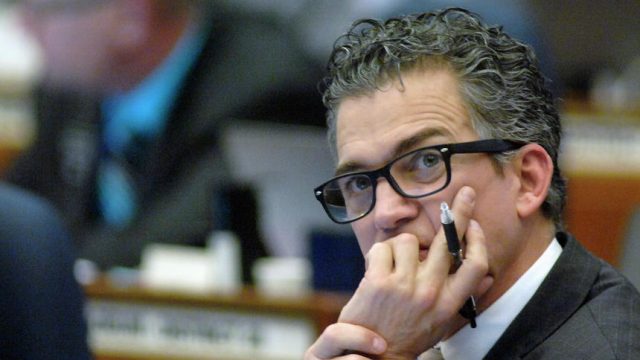Is the Bizarre Political Situation in Alaska a Sign of Things to Come in North Dakota?

Rep. Rick Becker, R-Bismarck, looks at the tally board on Tuesday during the 83-9 House vote on HB1169, a change to the North Dakota constitution allowing the carrying of a concealed firearm. Becker was a co-sponsor of the bill.
There are strange things happening in the State of Alaska.
“A deep divide over budget cuts in Alaska has become so acrimonious that two feuding factions of legislators cannot even agree on where they are supposed to meet, the latest twist in what may be the nation’s oddest political climate,” The Hill reports.
Republican Governor Mike Dunleavy wants deep cuts to the state’s budget, as well as a much larger distribution to citizens from the state’s Permanent Fund (that’s a pile of money, collected from the oil industry, from which Alaskans get annual payments). He’s backed by a faction of the state legislature.
Another faction of the legislature opposes Dunleavy.
The Governor called lawmakers into a special session to specifically address his Permanent Fund proposal, and he directed them to meet in Wasilla, which is in the Matanuska-Susitna Valley and one the most conservative areas of the state.
Dunleavy’s faction has gathered in Wasilla, but others are meeting in Juneau which is the state’s capital saying that while the Governor has the authority to call them into session he cannot direct them where to meet.
It’s a mess.
It could also be a preview of something brewing here in North Dakota.
Consider the parallels:
- Alaska, like North Dakota, is a state with a commodity-driven economy and a lot of oil.
- Alaska’s politics are quirky but mostly dominated by Republicans. North Dakota’s politics are also quirky, though heavily tilted toward Republicans.
- Alaska has the Permanent Fund which has been a political football since the day it was created. North Dakota has the much newer, and much smaller in terms of dollar size, Legacy Fund which is not yet committed to any purpose at all and will become a larger political football as its balance grows.
- Alaska’s legislature has the faction of arch conservative lawmakers who are following Governor Dunleavy’s lead. North Dakota’s Legislature has the Bastiat Caucus.
When political parties become as dominant as Republicans have been in North Dakota and Alaska, faction is inevitable. The more people you have in your party’s tent, the harder it is to reach consensus. What’s going on in Alaska is perhaps the worst case scenario for intra-party food fighting, and I suspect what the state will see is a political realignment, with some Republicans leaving the party to join independent/third party movements (of which there is a long tradition in Alaska) or the Democrats.
Could North Dakota be in the same situation? Is there be some controversy on the horizon to precipitate it?
The Bastiat Caucus in the Legislature is the most obvious potential epicenter for that sort of an earthquake, though typically they espouse loyalty to the Republican party and little desire to break away.
Still state Rep. Rick Becker, a Republican from Bismarck and founder of the Bastiat Caucus, ran for Governor in 2016 and got 37.75 percent of the vote from delegates at the NDGOP’s state convention (they ultimately chose Attorney General Wayne Stenehjem who, in turn, was defeated for the nomination by current Governor Doug Burgum on the statewide primary ballot).
A not at all insignificant portion of the Republican base in North Dakota is supportive of the Bastiat faction, and some fault lines are beginning to show. At the tail end of the last legislative session an amendment to the state Auditor’s budget created law forcing the Auditor to come begging to the Legislature for permission to audit. The legislation passed with majority support from most Republicans and all of the Democrats.
It was only the Bastiat faction who voted against it. Now there is a referendum campaign to put that legislation – along with two other bills – on the ballot for a possible electoral veto.
Time will tell if that referendum campaign gets traction with the public at large, but the similarities between North Dakota and Alaska are eerie, and possibly portentous.




